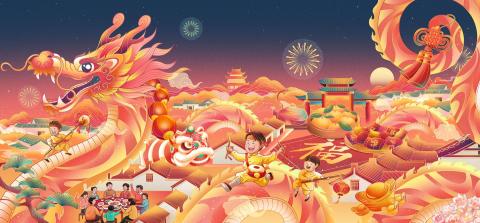The Chinese New Year, as one of China's most important traditional holidays, holds profound significance. It is not only the most crucial moment of the year for reunion for the Chinese people, but also an important symbol of Chinese culture and history.
The traditional customs of the Chinese New Year, including pasting couplets, setting off firecrackers, lion and dragon dances, have been passed down for thousands of years, embodying deep cultural connotations and beautiful meanings, showcasing the unique charm of the Chinese nation. With the increasing influence of the Chinese New Year, these customs have gradually spread worldwide.

Many countries have started organising Chinese New Year activities, attracting local residents and foreign tourists. For example, countries like the United States, Australia, and Canada hold grand Chinese New Year celebrations in their major cities, showcasing the charm of Chinese culture. Through performances such as lion and dragon dances, traditional music, and dance, people from around the world can experience the Chinese New Year culture up close.
Recently, the news that the traditional Chinese New Year has become a United Nations holiday has captured global attention. More and more countries and regions are paying attention to and participating in the celebration of the Spring Festival, even designating it as a statutory holiday. According to statistics, approximately one-fifth of the global population celebrates the Chinese New Year in various forms, and this number continues to grow.
The cultural significance of the Chinese New Year has attracted widespread attention.
Inheriting Chinese culture and promoting cultural exchange:
With the advancement of globalisation, cultural exchanges between countries have become increasingly frequent. Chinese culture, as one of the oldest and richest in the world, naturally becomes a focal point for people worldwide. Various celebratory activities during the Chinese New Year, such as dragon and lion dances and lantern festivals, are vital components of Chinese traditional culture, with a long history and rich cultural connotations. It represents Chinese people's anticipation and blessings for the new year, carrying important rituals such as family reunion, ancestral worship, and New Year greetings.
The recognition of the Chinese New Year as a United Nations holiday will help showcase the charm of Chinese traditional culture to the world and promote the inheritance and dissemination of Chinese culture. Through these activities, people worldwide can better understand and appreciate the charm of Chinese culture.
Driving economic development: China is one of the world's largest consumer markets, and the consumption boom during the Chinese New Year has a significant impact on the global economy. The business opportunities during the Chinese New Year have been recognised by an increasing number of countries and regions, leading them to introduce various incentives and unique products to attract Chinese tourists for tourism and shopping. This economic driving effect further promotes the global dissemination and influence of the Chinese New Year.
Increasing the international influence of humanitarian festivals: the Chinese New Year is a warm and caring holiday, emphasising family reunions and gatherings of friends and relatives. In this special season, people exchange blessings and gifts, expressing care and goodwill towards each other. This spirit of humanitarian care transcends national borders and cultural differences, resonating with people worldwide. The recognition of the Chinese New Year as a United Nations holiday will further enhance the image and influence of humanitarian festivals on the international stage.
The Influence of the Chinese New Year in International Metropolises

New York, USA: Every year, New York City hosts a grand Chinese New Year celebration, attracting hundreds of thousands of participants. From the countdown in Times Square to the flower-car parades in Chinatown, the Chinese New Year celebration has become one of the city's most popular cultural events. Recognising the Chinese New Year as an official holiday in New York not only allows local residents to better understand Chinese culture, but also serves as a bridge for cultural exchange between the people of China and the United States.
Paris, France: The Paris city government organises magnificent temple fairs during the Spring Festival, attracting crowds of tourists and locals. The fair features traditional Chinese lion and dragon dances, as well as various exhibitions of food and handicrafts. By designating the Chinese New Year as a statutory holiday, the Paris city government aims to promote cultural exchange between France and China, fostering friendship between the two nations.
Singapore: As a multicultural nation, Singapore hosts diverse activities during the Chinese New Year. The Singapore government recognises the Chinese New Year as a statutory holiday and holds a grand Chinese New Year lantern exhibition in the Marina Bay Gardens downtown. This lantern exhibition attracts visitors from around the world, showcasing the unique charm of Chinese traditional culture and promoting cultural exchange between Singapore and other countries.
With the Chinese New Year becoming a United Nations holiday, it not only acknowledges and promotes traditional Chinese culture but also, through various Chinese New Year activities, facilitates the inheritance and dissemination of Chinese culture. This, in turn, encourages communication and integration among different cultures, fostering increased understanding and friendship among people from various countries.

